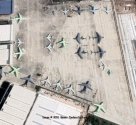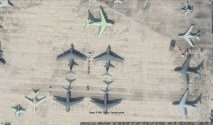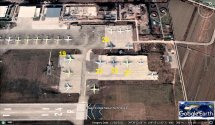This is how freight is loaded onto the cargo ship TP500, designed by the 603 Xi'an Institute of the AVIC group on behalf of the company Yitong UCA. The drone has a carrying capacity of 500kg. A larger version, TP2000, is currently in development..
You are using an out of date browser. It may not display this or other websites correctly.
You should upgrade or use an alternative browser.
You should upgrade or use an alternative browser.
Chinese UAV/UCAV development
- Thread starter AssassinsMace
- Start date
- Status
- Not open for further replies.
Is the TP500 battery powered or avigas powered?
This is how freight is loaded onto the cargo ship TP500, designed by the 603 Xi'an Institute of the AVIC group on behalf of the company Yitong UCA. The drone has a carrying capacity of 500kg. A larger version, TP2000, is currently in development..
Is the TP500 battery powered or avigas powered?
Of course not electric.
Interesting news today. UK's Spirit Mosquito project got canned for not having the right mix of cost and capabilities. For object of reference, here is the purported specs for it.
In terms of size and payload, it was noticeably larger than XQ-58A with comparable range.
It is however very similar to Boeing LTS MQ-28 in size (which is about 3t empty weight, also 11.6m long and 7.3 m wingspan) with similar ferry range.
It'd be interesting to see if the PLAAF loyal wingman look more like this or something like GJ-11. The former should be cheaper. The latter is larger, stealthier, with more room for EW/sensors along the leading edge of the wing and probably have better combat radius.
- Length - 12m
- Wingspan - 7.8m
- Weight (MTOW) - 3,200kg
- Range - 3,600km+
- Engine Thrust - 10,000lb turbofan
- Max. Speed - 650 mph
- Armament - 4.2m bay with 8 hardpoints with 900kg payload
In terms of size and payload, it was noticeably larger than XQ-58A with comparable range.
It is however very similar to Boeing LTS MQ-28 in size (which is about 3t empty weight, also 11.6m long and 7.3 m wingspan) with similar ferry range.
It'd be interesting to see if the PLAAF loyal wingman look more like this or something like GJ-11. The former should be cheaper. The latter is larger, stealthier, with more room for EW/sensors along the leading edge of the wing and probably have better combat radius.
(UTP hereby refers to Unmanned Transport Plane)
This is how freight is loaded onto the cargo ship TP500, designed by the 603 Xi'an Institute of the AVIC group on behalf of the company Yitong UCA. The drone has a carrying capacity of 500kg. A larger version, TP2000, is currently in development..
I wonder if AVIC and other relevant Chinese aviation R&D and manufacturing institutions and companies would design and produce future UTPs that can air drop their onboard cargo by remote control, instead of having to land every single time to offload their cargo?
I do understand that the weight of the parachutes needed to be taken into account alongside the cargo (which reduces the meaningful weight of cargo that is able to be carried onboard the UTP). This results in the benefits of having a parachute for the cargo becomes somewhat negligible for smaller UTPs.
However, if the cargo weight that could be transported by future UTPs can be increased significantly, there would be more weight allowance available for attaching a parachute to the cargo, therefore making the prospects of having those larger UTPs being able to airdrop their onboard cargo more viable.
With the parachute-cargo weight distribution solved, let's move on.
Based on what I could refer from the Wikipedia, the PLAAF currently has ~165 tactical airlifters with airdrop capabilities, which is centered around Y-8s, Y-9s, IL-76s and Y-20s.
Sounds impressive if you compare it to the likes of IAF (~40), ROKAF (~16), JASDF (~36) and ROCAF (~20). But when compared to the USAF and VVS, the tactical airlifting capabilities of the PLAAF still lags behind considerably (~606 and ~490 respectively). This means the logisitical strain on the PLA in resupplying their forces on the frontline would be far greater than that of USAF and VVS, as more sorties would have to be made in order to deliver the same amount of cargo.
This is also considering that China would be facing two broad warfronts respectively:
1. Himalayan Front - The logistical chain on the Chinese side would be much longer than that of the Indian side. Besides, the higher altitudes of the Tibetan Plateau means fewer airports and airbases that are further in between for China versus India where more of their airports and airbases are located at lower altitudes.
2. Western Pacific Front (here refers to Taiwan) - In the worst case scenario, China alone would have to face the firepower of not just Taiwan, but also the US, Japan, South Korea, Australia and the UK. In such scenario, the attrition rate for the logistical chain of the PLA would be pretty immense, as there would be more enemy fighters and aerial-denial weaponry that can be be deployed against the PLAAF. Moreover, the airports and airbases that are closer to the coastlines would be subjected to enemy attacks as well, therefore hampering the ability for the PLA to resupply their troops fighting on Taiwan.
Furthermore, I don't believe that the PLAAF would just throw all of their tactical airlifter fleet into one single front, as there are other regions/fronts to be guarded against as well.
So you see, the reason why I only brought up tactical airlifters with airdrop capabilities is mainly because of the following situations that are expected during wartime:
1. No useable runways available in the vicinity to land and offload cargo;
2. Dangerous terrain formation (mountains) that renders flying normal tactical airlifters risky, especially at low visibility conditions;
3. When troops on the ground require immediate resupply of weapons, ammunition, food and equipment, but no normal tactical airflifters are available for responding to said request; and/or
4. Significant enemy anti-air defense capabilities is still present in the airdrop area, rendering any attempt at resupplying the troops in that area (airdrop or landing to offload) risky and dangerous.
Therefore, while the PLAAF is building up her tactical airlifting capabilities to catch up with at least the VVS or the USAF (hopefully), I think that fielding more, larger UTPs with airdrop capabilities would be very useful in supplementing the tactical airlifting capabilities of the PLAAF. Apart from that, compared to full-sized normal tactical airlifters, these larger UTPs would be easier to contruct, take less resources and less time to construct, and can be literally "printed out" in larger numbers.
And this is why I believe that larger UTPs with airdrop capabilities would be extremely useful in the wars in both of the aforementioned fronts.
Speaking of cargo weight:
1. Y-8 can carry up to 20 tons;
2. Y-9 can carry up to 25 (or even 30) tons;
3. IL-76 can carry up to 48 tons; and
4. Y-20 can carry up to (estimated) 55-60 tons.
Hence, I think that the permissible weight of cargo that can be carried by these larger UTPs should hower at just below that of the Y-8s and Y-9s, which is somewhere around 15-18 tons. Such cargo weight allowance would be pretty sufficient to carry weapons, ammunition, food and equipment for airdrop. Besides, most, if not all types of ground-based military logistical vehicles (i.e. trucks and vans), especially armoured personnel carriers (APC) that are in the PLAGF's disposal can also be carried and airdropped by these UTPs as well. And I believe that armoured personnel carriers are very important in protecting and sheltering troop movements in urban warfare environments, of which Taiwan has a lot to offer.
Of course, I think that it would be even better for these UTPs to have the ability to operate from airstrips, as paved runways of airports and airbases would become a hard premium during war. But it really depends on the designers of those UTPs.
Last edited:
That is one hell of a UTP then, afterall aren't the next in line just a 2 ton cargo version?Speaking of cargo weight:
1. Y-8 can carry up to 20 tons;
2. Y-9 can carry up to 25 (or even 30) tons;
3. IL-76 can carry up to 48 tons; and
4. Y-20 can carry up to (estimated) 55-60 tons.
Hence, I think that the permissible weight of cargo that can be carried by these larger UTPs should hower at just below that of the Y-8s and Y-9s, which is somewhere around 15-18 tons. Such cargo weight allowance would be pretty sufficient to carry weapons, ammunition, food and equipment for airdrop. Besides, most, if not all types of ground-based military logistical vehicles (i.e. trucks and vans), especially armoured personnel carriers (APC) that are in the PLAGF's disposal can also be carried and airdropped by these UTPs as well. And I believe that armoured personnel carriers are very important in protecting and sheltering troop movements in urban warfare environments, of which Taiwan has a lot to offer.
Of course, I think that it would be even better for these UTPs to have the ability to operate from airstrips, as paved runways of airports and airbases would become a hard premium during war. But it really depends on the designers of those UTPs.
I can imagine it scaling up some more after the 2 ton (say 4-5 and maybe 8-10), but I feel like it's a stretch that it can reach 15-18 tons as well as enough room/volume for say APCs.
Or maybe not, who knows.
Yes, the TP2000 should carry up to 2 tons of cargo.That is one hell of a UTP then, afterall aren't the next in line just a 2 ton cargo version?
I can imagine it scaling up some more after the 2 ton (say 4-5 and maybe 8-10), but I feel like it's a stretch that it can reach 15-18 tons as well as enough room/volume for say APCs.
Or maybe not, who knows.
Although, my point above is how China should rapidly increase the tactical airfliting capabilities of the PLAAF as soon as possible by fielding more and larger UTPs, so that the PLAAF is at least on par with the VVS in that regard.
The geopolitical tension in the Western Pacific is heating up, and I do expect that the Taiwan scenario would not be going easy for the PLAAF at all.
To be honest, the immense challenges that would face the military logistical chains of the PLA just kinda scares the shit out of me.
Moreover, making sure your logistics are secure and stable is the backbone for any successful military operation anywhere in the world. You don't win a war on empty stomaches and empty magazines.
Yes, the TP2000 should carry up to 2 tons of cargo.
Although, my point above is how China should rapidly increase the tactical airfliting capabilities of the PLAAF as soon as possible by fielding more and larger UTPs, so that the PLAAF is at least on par with the VVS in that regard.
The geopolitical tension in the Western Pacific is heating up, and I do expect that the Taiwan scenario would not be going easy for the PLAAF at all.
To be honest, the immense challenges that would face the military logistical chains of the PLA just kinda scares the shit out of me.
Moreover, making sure your logistics are secure and stable is the backbone for any successful military operation anywhere in the world. You don't win a war on empty stomaches and empty magazines.
Would also make good assets in drone warfare, imagine 2 ton payload suicide drone.
Wikipedia is seriously outdated when it comes to Chinese military procurement. so you have taken total 31 units of Y-20. actually total airframes of Y-20 have crossed mark 55. aircraft is under serious mass production after WS-20 engine.Based on what I could refer from the Wikipedia, the PLAAF currently has ~165 tactical airlifters with airdrop capabilities, which is centered around Y-8s, Y-9s, IL-76s and Y-20s.
another very important thing to note, Y-20 have pulsating assembly line. means your production time have shortened almost half.
here are two different sets of satellite pictures. count number of Y-20Bs powered by WS-20 engines. so in couple of years PLAAF will have large fleet of Y-20.
WS-20 is in huge demand. Shenyang Aero engine firm already started to work on advance variant.
.
Attachments
Last edited:
- Status
- Not open for further replies.



